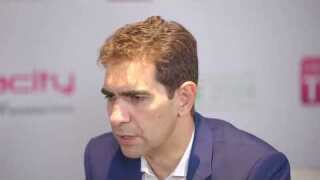In a recent statement, Malaysia's Communications and Digital Minister, Fahmi Fadzil, laid out the nation's ambitious plan for the "Golden Digital Decade."
The core of this vision revolves around Malaysia's active efforts to enhance its 5G infrastructure, positioning it as the key catalyst to propel the country into becoming the digital tiger of Asia—a truly remarkable aspiration.
Meeting the Demands of Tomorrow
When we examine the current trends, the typical Malaysian consumer currently uses approximately 25GB of data each month while spending an average of 5 hours on digital screens. Both these figures are expected to double within the next five to seven years. The planned 5G network and its related digital infrastructure, including towers, fibre optics and data centres, will form the foundation for achieving low-latency, high-speed connectivity and double the capacity of the telecommunications data network that our nation needs.
In today’s telecom sector, there’s a relentless race among market leaders to achieve a future where the cost per gigabyte (GB) of data consumption becomes more affordable, catering to the wider population. With this vision, people from all walks of life can economically enjoy Malaysia’s 5G-based data network and actively participate in the Digital Economy.
Unleashing the Potential of a Dynamic Network
The question we must now consider is: Can we transform the current static telecom tower-based network into a dynamic network and realise this vision?
Imagine driving home, and your spouse calls on WhatsApp to inquire about dinner plans. However, the call drops abruptly, and your phone displays a frustrating "Reconnecting" message — a scenario all too familiar. This problem often occurs in what we call "dark spots," areas with unstable or non-existent network connectivity. But what if there was a solution?

A potential solution could involve integrating traditional static towers with dynamic network elements such as electric cars and drones. In this scenario, when a call drops, a nearby vehicle or drone equipped with a cellular base station seamlessly picks up the connection. These mobile or portable stations and receivers can concentrate their efforts during peak traffic hours, efficiently meeting increased demand without the need for additional static towers.
In essence, this approach revolutionises the network, akin to the "Uberisation" of telecommunications, deploying small cells on electric vehicles, ride-sharing cars, or even carried by food delivery riders in backpacks.
This creates multiple coverage clusters, and the network dynamically adapts based on usage, significantly reducing costs for telecom operators. Suppliers of these network elements could potentially be compensated based on their usage, allowing, for example, a Grabfood delivery rider to earn monthly data usage for their family by covering a certain distance during the month, particularly in high-traffic areas during peak hours.
Bridging the Connectivity Gap
According to research conducted by Opensignal, Malaysia currently ranks fourth in average 5G download speeds, trailing behind South Korea, Singapore, and Brazil. This means that in scenarios like streaming the men's badminton finals, your friend in Seoul might post the results a few seconds ahead of you, despite both of you watching the same event.
In eight South and Southeast Asian markets, there are approximately one million "dark spots," defined as areas within a 500-meter radius with speeds below 8Mbps, and roughly 100 million under-connected mobile users. Bridging this connectivity gap with traditional towers and radio access network (RAN) solutions may be cost-prohibitive and unviable from a business perspective. What we genuinely need are more cost-effective, faster-to-deploy, and user-friendly network solutions.
Unlocking the Potential – Why Wait?
So, what's holding us back?
The world of telecom standards is governed by the "3rd Generation Partnership Project" (3GPP), which has already outlined the mobility aspect of telecom networks. Yet, we have not fully embraced this vision due to various technical challenges, handset limitations, and mobility factors that telecommunications engineers need to address.
Technology Gaps: The existing telecom backhaul technology responsible for transmitting calls from senders to receivers is currently rigid. To ensure consistent wireless backhaul transmission, communication between sender and receiver needs to remain stationary, or signal loss may occur. Additionally, cells are confined to specific areas without authorisation beyond their designated range. Coverage overlaps can result in significant frequency interference, as numerous devices emit licensed frequencies within a small radius.
Handset Evolution: The next generation of mobile devices must be compact, energy-efficient, and capable of withstanding outdoor conditions to accommodate dynamic networks.
Mobility Matters: Several factors come into play, including built-in antennas on devices, proximity to the macro tower providing service, weather conditions, network congestion, local topography, vehicle construction, and vehicle speed.

A Vision for a Dynamic Network
One remarkable innovation within the realm of 3GPP standards is Cellular Vehicle-to-Everything (C-V2X). This groundbreaking technology empowers vehicles to communicate not only with other vehicles but also with surrounding entities, including other vehicles, cyclists, pedestrians, road infrastructure, and mobile networks. The primary aim is to enhance safety, intelligence, and the overall driving and travel experience. It's important to note that C-V2X primarily facilitates machine-to-machine communication rather than human interaction.
In practical terms, C-V2X creates a network that links machines, specifically vehicles, to interact with their environment. This includes communication with other vehicles, cyclists, pedestrians, road infrastructure, or mobile networks.
To facilitate a broader transportation ecosystem, C-V2X users rely on two complementary transmission modes. First, there's direct communications (PC5), which operates independently of cellular networks, enabling vehicles to communicate directly with other road users like cyclists, pedestrians, or other vehicles.
Second, there are network communications (Uu), which leverage conventional mobile networks to provide vehicles with real-time information about road conditions and local traffic. This approach departs from traditional radio broadcasts and fellow Waze users.
Think of modern electric vehicles like Tesla and BYD, where vehicles can "communicate" with each other to adjust their speed and maintain synchronized control with other vehicles on the road. Additionally, imagine your vehicle providing spoken directions, navigating through traffic, and avoiding potential collisions with pedestrians and other vehicles.
C-V2X also supports V2N applications using existing cellular networks for voice and data communications. V2N plays a crucial role in delivering network assistance and commercial services, often involving the participation of Mobile Network Operators.

A Mission Worth Pursuing
In conclusion, we stand on the verge of extending Cellular Vehicle-to-Everything (C-V2X) to connect mobile users. The economic benefits of establishing an affordable network infrastructure are clear - reducing the cost per gigabyte and tripling the data capacity required in the coming decade.
If the world can develop a vaccine for Covid-19 from scratch in less than 12 months, why can’t we leverage the expertise of top telecom professionals to develop and implement standards and associated network elements for a dynamic network before the decade’s end? This pursuit is not just for the sake of innovation but for the greater good, aligning perfectly with Malaysia’s ambitious goal of becoming the digital tiger of Asia - a goal that can be achieved with a forward-thinking approach to telecommunications.
About the writer
Gayan Koralage is a prominent trailblazer within the Edotco Group, having played a pioneering role since its inception. He is a seasoned speaker and writer, recognised as a thought leader within the mobile and neutral-party-host telecom tower industry, focusing on critical topics such as the business rationale for 5G, network disruption, digital economy, digital transformation and inter-generation opportunities.
In his current capacity as the Director of Group Strategy, he assumes a pivotal role in shaping the organisation’s long-term strategy, overseeing pricing strategies and commercial initiatives. Since 2013, Gayan has been the driving force behind EDOTCO’s inception and expansion, propelling it to prominence as one of the top six tower companies globally. His efforts have led to an impressive presence across nine Asian markets, solidifying Edotco’s status as an industry leader.





